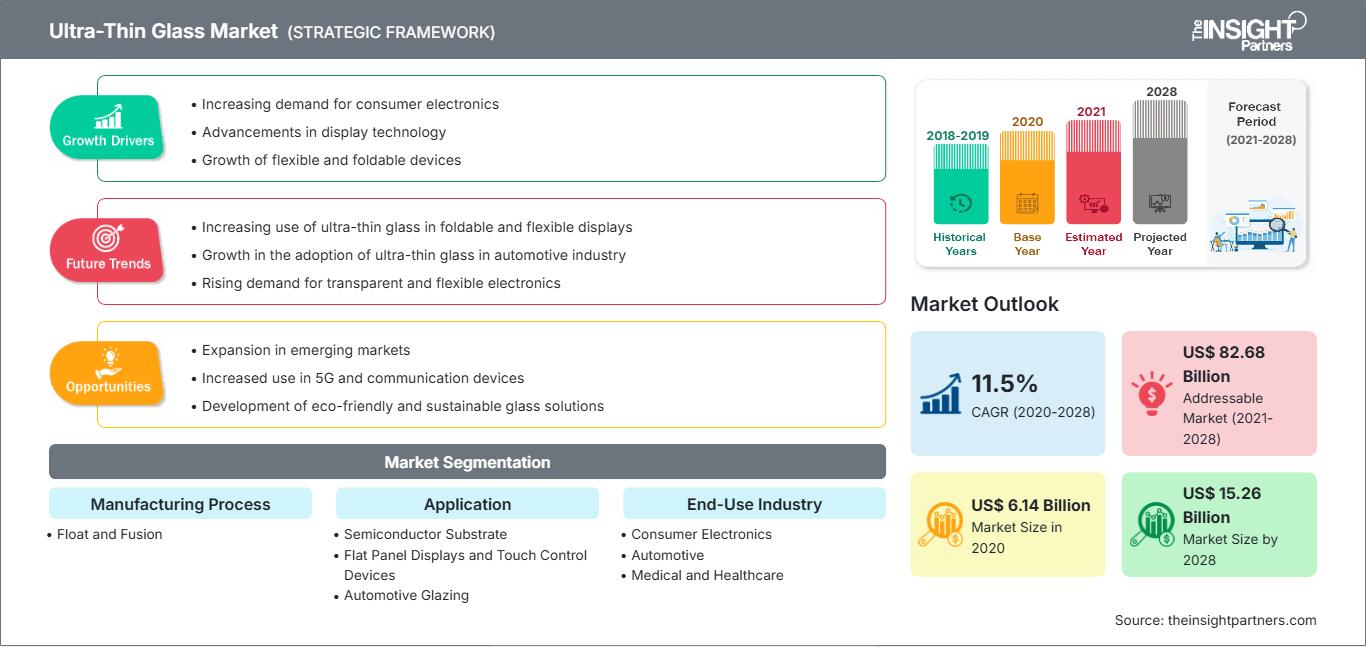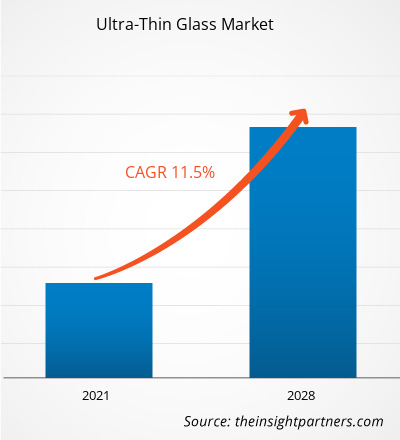[Rapport de recherche] Le marché du verre ultra-mince était évalué à 6 139,56 millions de dollars américains en 2020 et devrait atteindre 15 264,74 millions de dollars américains d'ici 2028 ; il devrait croître à un TCAC de 11,5 % entre 2021 et 2028.
Le verre ultra-mince est un verre dont l'épaisseur est inférieure à 1 à 2 mm.
Le renforcement chimique par échange d'ions est couramment utilisé pour renforcer le verre ultra-mince utilisé dans les applications de haute technologie.Le verre ultra-mince durci est résistant aux rayures et pliable jusqu'à un rayon de quelques millimètres. Les propriétés du verre ultra-mince, telles que la résistance à la corrosion, la transparence, la flexibilité, une excellente barrière aux gaz et à l'eau et une résistance élevée aux chocs, le rendent adapté à diverses applications telles que les écrans plats et le vitrage automobile, entre autres. En 2020, l'Asie-Pacifique détenait la plus grande part de chiffre d'affaires du marché mondial du verre ultra-mince. La Chine est le plus grand consommateur de verres ultra-minces, représentant plus de 50 % des parts de marché en Asie-Pacifique. Le pays est le principal centre de fabrication de tous types de produits électroniques grand public, tels que les smartphones et les écrans LCD.La pandémie de COVID-19 en cours a radicalement modifié la situation du secteur des produits chimiques et des matériaux et a eu un impact négatif sur la croissance du marché du verre ultra-mince.
La mise en œuvre de mesures pour lutter contre la propagation du nouveau coronavirus a aggravé la situation et a eu un impact négatif sur la croissance de plusieurs secteurs. Des industries telles que l'automobile et l'électronique grand public ont été affectées par la distorsion soudaine de l'efficacité opérationnelle et les perturbations des chaînes de valeur dues à la fermeture soudaine des frontières nationales et internationales. Le déclin de la croissance de plusieurs secteurs a eu un impact négatif sur la demande de verre ultra-mince sur le marché mondial. Cependant, alors que les économies prévoient de relancer leurs activités, la demande de verre ultra-mince devrait augmenter à l'échelle mondiale dans les années à venir. En raison de la pandémie, le télétravail et l'enseignement en ligne se généralisent. Par conséquent, la demande de produits tels que les ordinateurs portables, les smartphones et autres appareils de télécommunication augmente. La demande croissante de verre ultra-mince dans divers secteurs, tels que l'automobile et l'électronique grand public, ainsi que les investissements importants des principaux fabricants, devraient stimuler la croissance du marché du verre ultra-mince au cours de la période de prévision.Vous bénéficierez d’une personnalisation sur n’importe quel rapport - gratuitement - y compris des parties de ce rapport, ou une analyse au niveau du pays, un pack de données Excel, ainsi que de profiter d’offres exceptionnelles et de réductions pour les start-ups et les universités
Marché du verre ultra-mince: Perspectives stratégiques

-
Obtenez les principales tendances clés du marché de ce rapport.Cet échantillon GRATUIT comprendra une analyse de données, allant des tendances du marché aux estimations et prévisions.
L'industrie de l'électronique grand public est en plein essor grâce à l'utilisation croissante d'appareils électroniques, tels que les smartphones, les ordinateurs portables, les téléviseurs et autres produits électroniques. Les biens électroniques grand public sont devenus une nécessité dans le monde technologique. Les personnes de toutes générations sont, d'une manière ou d'une autre, dépendantes de leurs smartphones, montres connectées et ordinateurs portables. Face à la croissance de l'industrie de l'électronique grand public, les fabricants se concentrent en permanence sur la fourniture de produits avancés et de haute qualité. Le verre ultra-mince joue un rôle important dans l'industrie de l'électronique grand public. Il est utilisé dans les écrans tactiles et d'affichage, les capteurs et les systèmes de caméra. Diverses propriétés du verre ultra-mince, telles que la résistance à la corrosion, la transparence, la flexibilité et la capacité de barrière aux gaz, le rendent adapté à de nombreuses applications dans l'industrie de l'électronique grand public. La Chine domine le secteur des biens électroniques grand public. Le pays est l'un des principaux fabricants d'écrans plats. La demande de smartphones, de trackers d'activité, de téléviseurs et d'autres produits électroniques chinois augmente rapidement, ce qui offre des opportunités lucratives aux fabricants de verre ultra-mince. La Chine a renforcé la construction de nouvelles infrastructures ; Français a favorisé le développement de l'intelligence artificielle, de l'Internet industriel et de l'Internet des objets ; et a accéléré le rythme de commercialisation de la 5G, propulsant ainsi l'industrie de la fabrication de l'information électronique vers une nouvelle étape de développement et favorisant le développement haut de gamme des industries connexes. Selon World Population Review, la Chine compte 1,6 milliard d'utilisateurs de téléphones portables, et l'Inde 1,28 milliard. En 2018, Apple a enregistré environ 22,5 millions d'expéditions de montres connectées. Ce chiffre est en hausse par rapport à 2017, l'entreprise ayant vendu 17,7 millions d'unités en 2017. En 2018, Fitbit a expédié environ 5,5 millions d'unités de montres connectées, tandis que Samsung en a expédié environ 5,3 millions. Ainsi, la croissance rapide du secteur de l'électronique grand public stimule la demande de verres ultra-minces.
Informations sur l'industrie d'utilisation finale
Le segment de l'électronique grand public détenait la plus grande part du marché mondial du verre ultra-mince en 2020. Le verre ultra-mince est largement utilisé dans la fabrication de produits électroniques, tels que les écrans plats et les écrans tactiles pour divers appareils, tels que les écrans LCD, les OLED, les smartphones et les appareils portables. Avec la demande croissante de produits électroniques innovants et technologiquement avancés dans le monde, la demande de verres ultra-minces devrait augmenter dans les années à venir.
Informations sur le processus de fabrication
Par procédé de fabrication, le segment de la fusion a dominé le marché du verre ultra-mince en termes de chiffre d'affaires en 2020. Le procédé de fusion, souvent appelé méthode d'étirage par débordement, est largement utilisé pour fabriquer des verres plats ultra-minces pour les panneaux d'affichage. Corning a été la première entreprise à créer un verre spécialisé suspendu dans l'air, ce qui est une caractéristique clé de la méthode de fusion. Le verre n'entre pas en contact avec le métal en fusion, ce qui constitue un avantage fondamental de la méthode de fusion par rapport à la méthode du verre flotté.
Quelques-uns des principaux acteurs du marché du verre ultra-mince sont Corning Incorporated ; AGC Inc. ; Nippon Electric Glass Co., Ltd. ; SCHOTT AG ; Central Glass Co., Ltd. ; CSG Holding Co., Ltd. ; Emerge Glass ; Nippon Sheet Glass Co., Ltd ; Xinyi Glass Holdings Limited ; et Luoyang Glass Co., Ltd. Les principaux acteurs du marché adoptent des stratégies telles que les fusions et acquisitions et les lancements de produits pour étendre leur présence géographique et leur clientèle.
Marché du verre ultra-minceLes tendances et facteurs régionaux influençant le marché du verre ultra-mince tout au long de la période de prévision ont été analysés en détail par les analystes de The Insight Partners. Cette section aborde également les segments et la répartition géographique du marché du verre ultra-mince en Amérique du Nord, en Europe, en Asie-Pacifique, au Moyen-Orient et en Afrique, ainsi qu'en Amérique du Sud et en Amérique centrale.
Portée du rapport sur le marché du verre ultra-mince| Attribut de rapport | Détails |
|---|---|
| Taille du marché en 2020 | US$ 6.14 Billion |
| Taille du marché par 2028 | US$ 15.26 Billion |
| TCAC mondial (2020 - 2028) | 11.5% |
| Données historiques | 2018-2019 |
| Période de prévision | 2021-2028 |
| Segments couverts |
By Procédé de fabrication
|
| Régions et pays couverts |
Amérique du Nord
|
| Leaders du marché et profils d'entreprises clés |
|
Densité des acteurs du marché du verre ultra-mince : comprendre son impact sur la dynamique commerciale
Le marché du verre ultra-fin connaît une croissance rapide, portée par une demande croissante des utilisateurs finaux, due à des facteurs tels que l'évolution des préférences des consommateurs, les avancées technologiques et une meilleure connaissance des avantages du produit. Face à cette demande croissante, les entreprises élargissent leur offre, innovent pour répondre aux besoins des consommateurs et capitalisent sur les nouvelles tendances, ce qui alimente la croissance du marché.
- Obtenez le Marché du verre ultra-mince Aperçu des principaux acteurs clés
- Tendances progressives dans l'industrie du verre ultra-mince pour aider les acteurs à développer des stratégies efficaces à long terme
- Stratégies de croissance commerciale adoptées par les entreprises pour assurer la croissance sur les marchés développés et en développement
- Analyse quantitative du marché mondial du verre ultra-mince de 2019 à 2028
- Estimation de la demande de verre ultra-mince dans divers secteurs
- Analyse de Porter pour illustrer l'efficacité des acheteurs et des fournisseurs opérant dans l'industrie pour prédire la croissance du marché
- Évolutions récentes pour comprendre le scénario de marché concurrentiel et la demande de verre ultra-mince
- Tendances et perspectives du marché associées aux facteurs qui stimulent et freinent la croissance du marché du verre ultra-mince
- Compréhension des stratégies qui sous-tendent l'intérêt commercial concernant la croissance du marché mondial du verre ultra-mince, aidant au processus de prise de décision
- Taille du marché du verre ultra-mince à différents nœuds du marché
- Aperçu détaillé et Segmentation du marché mondial du verre ultra-mince et dynamique de son secteur
- Taille du marché du verre ultra-mince dans diverses régions avec des opportunités de croissance prometteuses
Marché du verre ultra-mince, par procédé de fabrication
- Flotteur
- Fusion
Marché du verre ultra-mince, par application
- Substrat semi-conducteur
- Écrans plats et dispositifs de commande tactile
- Vitrage automobile
- Autres
Marché du verre ultra-mince, par secteur d'utilisation finale
- Électronique grand public
- Automobile
- Médical et soins de santé
- Autres
Profils d'entreprise
- Corning Incorporated
- AGC Inc.
- Nippon Electric Glass Co., Ltd.
- SCHOTT AG
- Central Glass Co., Ltd.
- CSG Holding Co., Ltd.
- Emerge Glass
- Nippon Sheet Glass Co., Ltd
- Xinyi Glass Holdings Limited
- Luoyang Glass Co., Ltd
- Analyse historique (2 ans), année de base, prévision (7 ans) avec TCAC
- Analyse PEST et SWOT
- Taille du marché Valeur / Volume - Mondial, Régional, Pays
- Industrie et paysage concurrentiel
- Ensemble de données Excel
Rapports récents
Rapports connexes
Témoignages
Raison d'acheter
- Prise de décision éclairée
- Compréhension de la dynamique du marché
- Analyse concurrentielle
- Connaissances clients
- Prévisions de marché
- Atténuation des risques
- Planification stratégique
- Justification des investissements
- Identification des marchés émergents
- Amélioration des stratégies marketing
- Amélioration de l'efficacité opérationnelle
- Alignement sur les tendances réglementaires






















 Obtenez un échantillon gratuit pour - Marché du verre ultra-mince
Obtenez un échantillon gratuit pour - Marché du verre ultra-mince